Trunk and branches fungi – prevention and control
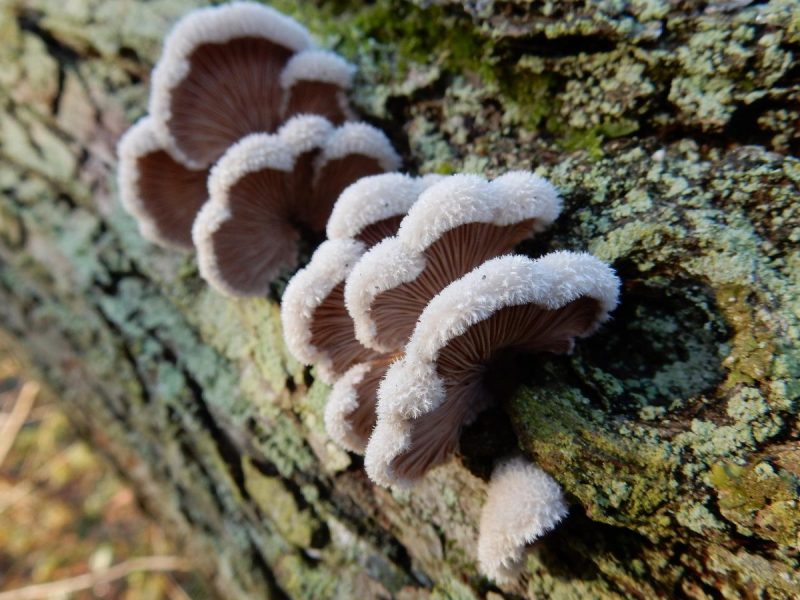
Diseases of the bark, trunk, and the area between the roots and the stem are caused by various fungi that spread en masse during the vegetative growth period. The fungi of the trunk and branches attack the trees and cause cankers, the most prone being declining trees, which have exceeded the maximum fruiting period. Trees that suffer mechanical damage from various causes and those that are weakened are also the target of attacks by these fungi.
Treating the tree is difficult and often incomplete, so it is more effective and easier to prevent the appearance of fungi than to control them.
Hoof fungus (Fomes fomentarius)
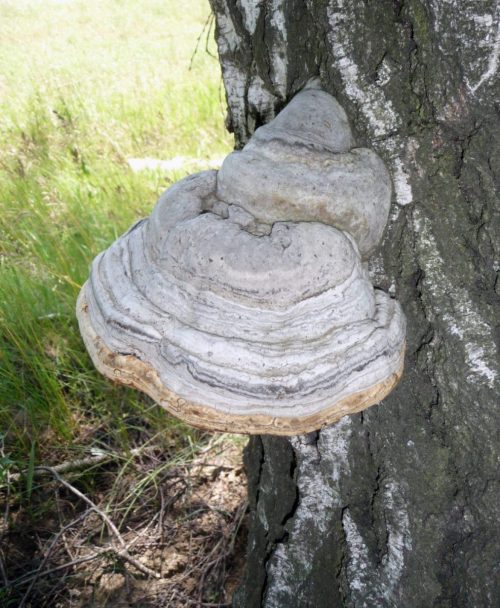
These fungi also grow on dead trunks, but it prefers the living trunks of various deciduous trees such as beech, elm, hornbeam, oak, ash, poplar, acacia, chestnut, etc. It can be found all year round and it produces a white wood rot.
The fungi attack the sapwood, then enter the duramen, where the main attack takes place. The attacked wood rots and is initially colored in dark brown. Later, all the wood rots become brittle and crack.
Controlling these fungi is very difficult. The prevention of the attack can be carried out through phytosanitary measures.
Splitgill mushroom (Schizophyllum commune)
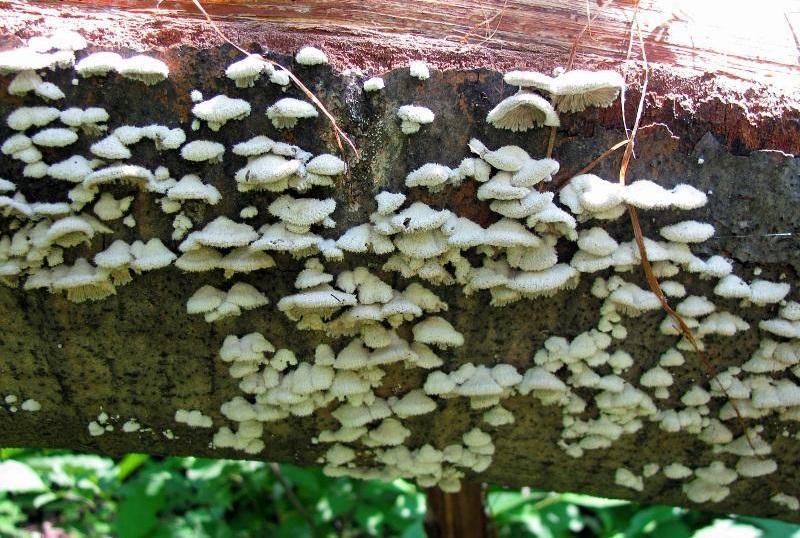
The saprophytic fungus grows on most deciduous trees and causes wood rot. It can also be found in fruit trees. The mycelium of the fungus grows between the bark and the wood and destroys the cambium, sapwood, and duramen. The attacked branches dry out and break easily.
To prevent the attack, the trees must not be injured.
Honey fungus (Armillaria mellea)
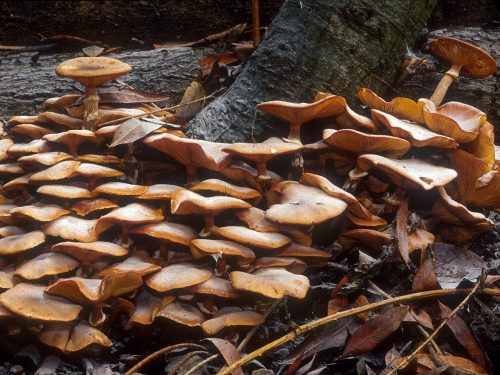
It is a polyphagous species, being very damaging to most conifers, deciduous trees, fruit trees, and herbaceous plants. It appears on specimens of all ages and causes the white wood rot.
The attacked trees have yellowed foliage, and the branches dry out, especially towards the top of the crown. Also, the resin can be seen on the root or near the area between the roots and the stem. During the year, the presence of the fungus can be recognized thanks to its mycelium in the form of fans.
Nectria canker (Nectria galligena)
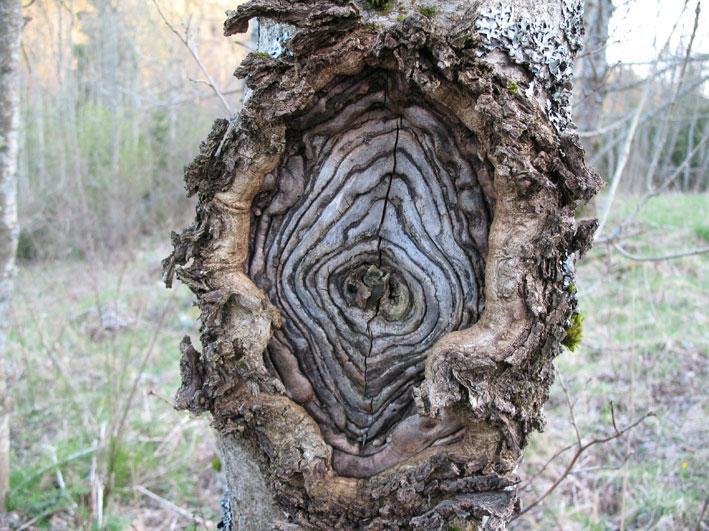
It can be found in orchards, nurseries, gardens, and parks, on trees, or on ornamental plants. Nectria canker is specific to apple trees but also other species such as beech, linden, acacia, maple, walnut, Japanese acacia, etc. The fungus attacks the bark of the tree, causing ulcerations. Then, the wound becomes deep and causes the death of the branch or the entire tree, if the ulceration is on the stem.
Usually, cankers caused by this fungus are developed near a bud or near a lesion produced mechanically by insects (Eriosoma lanigerum), pruning, hail, or other fungi.
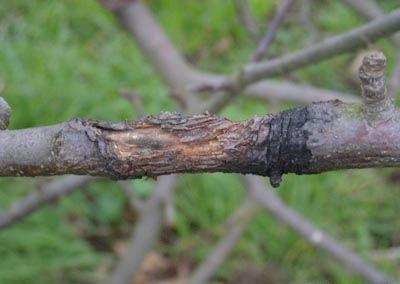
At the site of infection, a small reddish-brown spot appears, which extends both to the surface and in-depth. The bark, at first smooth, is grooved, and at a more advanced stage, it becomes exfoliated and the wood remains exposed. Healthy bark reacts by producing every spring a wave of covering tissue at the periphery of these affected areas. Thus, the edges of the wound thicken. If the covering tissue stops growing before it covers the wound, then it develops into an “open canker.” If the tissue manages to completely cover the wound, which has the appearance of a swollen knot, the so-called “closed canker” is formed. Over time, the affected area spreads and may partially or surround the branch, which dries up from the place of the attack.
Prevention and control measures:
To prevent the appearance of the fungus, only certified planting material must be procured. The horticultural tools have to be disinfected, the necrosis and cankers on the stems must be removed until the healthy tissue is reached and the wounds must be covered with a solution based on copper and then with mastic. The affected branches that have been cut must be destroyed by burning.
Recommended products
-
You can find products on a different store
Change Store -
You can find products on a different store
Change Store -
You can find products on a different store
Change Store -
You can find products on a different store
Change Store -
You can find products on a different store
Change Store -
You can find products on a different store
Change Store -
You can find products on a different store
Change Store -
You can find products on a different store
Change Store -
You can find products on a different store
Change Store -
You can find products on a different store
Change Store -
You can find products on a different store
Change Store -
You can find products on a different store
Change Store -
You can find products on a different store
Change Store -
You can find products on a different store
Change Store -
You can find products on a different store
Change Store -
You can find products on a different store
Change Store -
You can find products on a different store
Change Store -
You can find products on a different store
Change Store -
You can find products on a different store
Change Store -
You can find products on a different store
Change Store -
You can find products on a different store
Change Store -
You can find products on a different store
Change Store -
You can find products on a different store
Change Store -
You can find products on a different store
Change Store
Recommended products
-
You can find products on a different store
Change Store -
You can find products on a different store
Change Store -
You can find products on a different store
Change Store -
You can find products on a different store
Change Store -
You can find products on a different store
Change Store -
You can find products on a different store
Change Store -
You can find products on a different store
Change Store -
You can find products on a different store
Change Store -
You can find products on a different store
Change Store -
You can find products on a different store
Change Store -
You can find products on a different store
Change Store -
You can find products on a different store
Change Store -
You can find products on a different store
Change Store -
You can find products on a different store
Change Store -
You can find products on a different store
Change Store -
You can find products on a different store
Change Store -
You can find products on a different store
Change Store -
You can find products on a different store
Change Store -
You can find products on a different store
Change Store -
You can find products on a different store
Change Store -
You can find products on a different store
Change Store -
You can find products on a different store
Change Store -
You can find products on a different store
Change Store -
You can find products on a different store
Change Store
Root rot (Phytophthora cactorum)
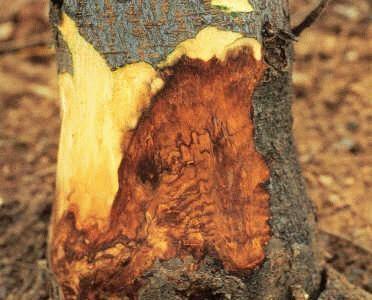
It is a disease known in different areas of apple tree cultivation, but in the literature, other species are also mentioned: pear, apricot, plum, cherry, currant trees, European gooseberry, blueberry, strawberry, and walnut.
The disease manifests on the stem, branches, and fruits. Usually, the attack starts above the grafting point, in the form of a wet spot. The bark turns purple and over time it turns brownish-gray. The tissue under the bark is red or brown, with a spongy consistency. Under favorable conditions of high heat and humidity, the fungus can attack the stem all around. The attack on the fruit manifests through a brown spot, with an irregular outline. The fungus penetrates the pulp of the fruit and causes it to rot.
Preventive measures:
Agrotechnical methods of disease prevention recommend balanced fertilization, rational irrigation, the removal of host plants for Phytophthora cactorum, and avoiding damaging the trees.
Phomopsis canker (Phomopsis mali)
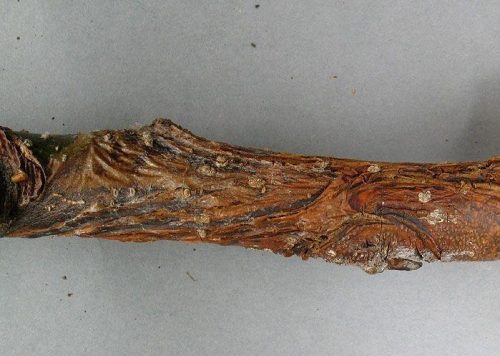
It attacks apple, pear, plum, cherry trees, grapevine, etc. The fungus attacks the branches, causing cankers, especially at the grafting point. A massive attack can weaken the tree and damage the bark around the trunk. The disease is favored by high atmospheric humidity.
Black rot (Sphaeropsis malorum)
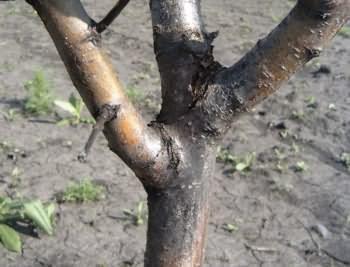
The fungus attacks especially the apple and pear trees, rarely the apricot, cherry, and plum trees. It causes cankers in lesions caused by frost, insects, cuts, grafting points. The disease is favored by high humidity. The sources of the infection are the mummified fruits from the trees and the bark cankers.
Dryad’s saddle (Polyporus squamosus)
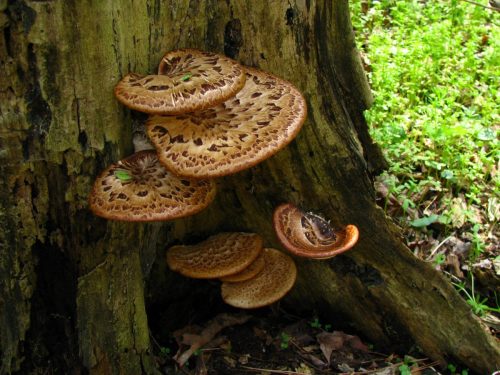
It is an annual fungus, saprophytic and parasitic, growing on both the trunks of living trees and the dry ones. It appears alone or in groups, on the trunks of walnut, elm, or other hardwood trees. It can be found especially in spring, in April-May, but it can also be found in summer or autumn.
The cap can reach a diameter of 60 cm, is fan-shaped, with a deep hole in the insertion area of the stalk. The color of the cap varies between yellow and brown and is covered with brown scales that tend to darken in color over time. The stalk is short, facing the bark of the tree.
The fungus causes white rot of the trunk or branches on which it grows. At first, the wood becomes brittle, spongy, later developing cavities in the attacked part. This way, the wood breaks easily. Usually, the fruit of the mushroom (cap) appears on a wound of the trunk or branch, the fungus penetrating the wood through this wound.
Prevention and control measures:
If this fungus appears, remove the fruiting body of the fungus, clean the affected portion and treat with copper fungicides. To protect the injured area, apply mastic.
Recommended products
-
You can find products on a different store
Change Store -
You can find products on a different store
Change Store -
You can find products on a different store
Change Store -
You can find products on a different store
Change Store -
You can find products on a different store
Change Store -
You can find products on a different store
Change Store -
You can find products on a different store
Change Store -
You can find products on a different store
Change Store -
You can find products on a different store
Change Store -
You can find products on a different store
Change Store -
You can find products on a different store
Change Store -
You can find products on a different store
Change Store -
You can find products on a different store
Change Store -
You can find products on a different store
Change Store -
You can find products on a different store
Change Store -
You can find products on a different store
Change Store -
You can find products on a different store
Change Store -
You can find products on a different store
Change Store -
You can find products on a different store
Change Store -
You can find products on a different store
Change Store -
You can find products on a different store
Change Store -
You can find products on a different store
Change Store -
You can find products on a different store
Change Store -
You can find products on a different store
Change Store
Recommended products
-
You can find products on a different store
Change Store -
You can find products on a different store
Change Store -
You can find products on a different store
Change Store -
You can find products on a different store
Change Store -
You can find products on a different store
Change Store -
You can find products on a different store
Change Store -
You can find products on a different store
Change Store -
You can find products on a different store
Change Store -
You can find products on a different store
Change Store -
You can find products on a different store
Change Store -
You can find products on a different store
Change Store -
You can find products on a different store
Change Store -
You can find products on a different store
Change Store -
You can find products on a different store
Change Store -
You can find products on a different store
Change Store -
You can find products on a different store
Change Store -
You can find products on a different store
Change Store -
You can find products on a different store
Change Store -
You can find products on a different store
Change Store -
You can find products on a different store
Change Store -
You can find products on a different store
Change Store -
You can find products on a different store
Change Store -
You can find products on a different store
Change Store -
You can find products on a different store
Change Store
Coral spot (Nectria cinnabarina)
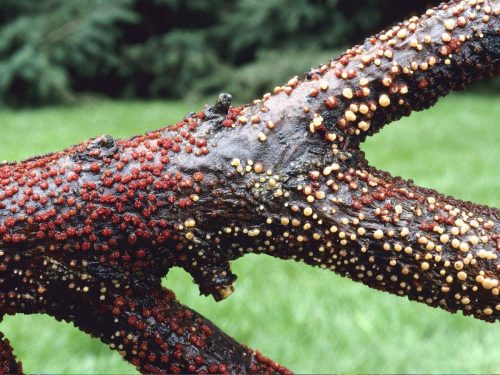
The disease occurs on the branches of trees, shrubs, and forest species that are exposed to low temperatures or the attack of insects and various fungi. The attack occurs during the vegetative growth period and manifests through the drying of the branches and bark, which are then covered by reddish mycelial pustules. The fungus penetrates the bark and wood and consumes the lignin, the wood acquiring a whitish color due to the remaining cellulose. The transmission from one year to another is done through the mycelium, and the spreading during the vegetative growth period is via spores.
Prevention and control measures:
The dry and weakened branches must be removed, the wounds disinfected with cupric fungicides, and coated with mastic. It is recommended to apply fertilizers rationally and to respect the cultivation technology according to the species.
Recommended products
-
You can find products on a different store
Change Store -
You can find products on a different store
Change Store -
You can find products on a different store
Change Store -
You can find products on a different store
Change Store -
You can find products on a different store
Change Store -
You can find products on a different store
Change Store -
You can find products on a different store
Change Store -
You can find products on a different store
Change Store -
You can find products on a different store
Change Store -
You can find products on a different store
Change Store -
You can find products on a different store
Change Store -
You can find products on a different store
Change Store -
You can find products on a different store
Change Store -
You can find products on a different store
Change Store -
You can find products on a different store
Change Store -
You can find products on a different store
Change Store -
You can find products on a different store
Change Store -
You can find products on a different store
Change Store -
You can find products on a different store
Change Store -
You can find products on a different store
Change Store -
You can find products on a different store
Change Store -
You can find products on a different store
Change Store -
You can find products on a different store
Change Store -
You can find products on a different store
Change Store
Recommended products
-
You can find products on a different store
Change Store -
You can find products on a different store
Change Store -
You can find products on a different store
Change Store -
You can find products on a different store
Change Store -
You can find products on a different store
Change Store -
You can find products on a different store
Change Store -
You can find products on a different store
Change Store -
You can find products on a different store
Change Store -
You can find products on a different store
Change Store -
You can find products on a different store
Change Store -
You can find products on a different store
Change Store -
You can find products on a different store
Change Store -
You can find products on a different store
Change Store -
You can find products on a different store
Change Store -
You can find products on a different store
Change Store -
You can find products on a different store
Change Store -
You can find products on a different store
Change Store -
You can find products on a different store
Change Store -
You can find products on a different store
Change Store -
You can find products on a different store
Change Store -
You can find products on a different store
Change Store -
You can find products on a different store
Change Store -
You can find products on a different store
Change Store -
You can find products on a different store
Change Store
Fusicoccum amygdali
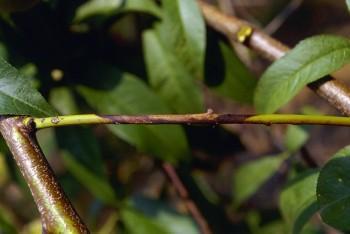
It is a common disease in peach and apricot trees, causing significant damage. The fungus penetrates through the wounds caused by cuts, the attack of insects, or hail. The attack manifests on one-year shoots, starting in spring and continuing in the following years. A reddish-brown or dark brown spot appears around the buds or at the base of the new shoots. Symptoms are accompanied by the presence of mucilage. On the leaves, large, irregularly shaped brown spots appear. The attacked fruits rot. The fungus produces the toxin fusicoccin, which dries out the affected buds and shoots.
The fungus persists in the attacked branches, in spring developing fructifications and spores. Following injury, the spores ensure the growth of the fungus and the occurrence of new infections.
Prevention and control measures:
Treatments carried out in autumn after the leaves fall and in spring, before bud swelling, can limit the attack of this fungus. When the disease occurs, it is recommended to remove and destroy the affected parts and apply treatments with cupric fungicides.
Recommended products
-
You can find products on a different store
Change Store -
You can find products on a different store
Change Store -
You can find products on a different store
Change Store -
You can find products on a different store
Change Store -
You can find products on a different store
Change Store -
You can find products on a different store
Change Store -
You can find products on a different store
Change Store -
You can find products on a different store
Change Store -
You can find products on a different store
Change Store -
You can find products on a different store
Change Store -
You can find products on a different store
Change Store -
You can find products on a different store
Change Store -
You can find products on a different store
Change Store -
You can find products on a different store
Change Store -
You can find products on a different store
Change Store -
You can find products on a different store
Change Store -
You can find products on a different store
Change Store -
You can find products on a different store
Change Store -
You can find products on a different store
Change Store -
You can find products on a different store
Change Store -
You can find products on a different store
Change Store -
You can find products on a different store
Change Store -
You can find products on a different store
Change Store -
You can find products on a different store
Change Store
Leucostoma canker (Valsa leucostoma)
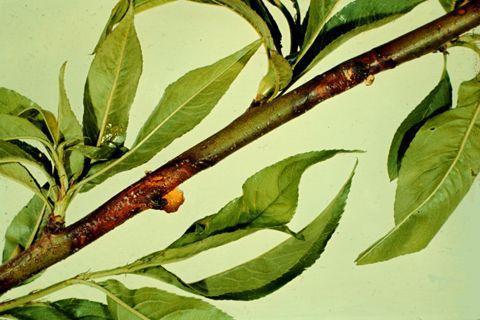
The disease can be found in old and untended orchards of plum, apricot, and peach trees. The branches of the attacked trees have few, small leaves, yellow in color, which fall prematurely. These branches dry from top to bottom. Gray or brown spots appear on the bark of the shoots, which become bigger. When it attacks seedlings, the disease can cause them to dry out completely. On the attacked branches occur mucilaginous leaks and fungus fruiting bodies, in the form of whitish discs.
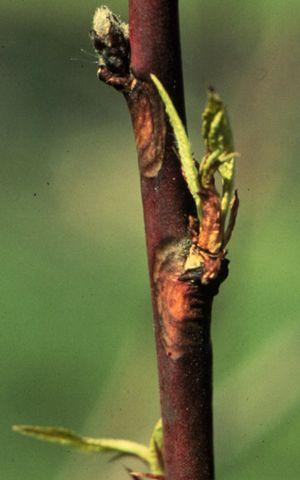
Infection on young branches manifests itself in the form of discolored and deepened areas, showing dark and light concentric areas. These spots usually appear around winter-dried buds. One-year-old shoots, located in the center of the crown, are more prone to attack. The attack on the trunk and older branches manifest through cankers accompanied by excessive mucilage.
The fungus overwinters in the bark of the branches in the form of a resistant fungus. In spring, spores are developed that will ensure new infections.
Prevention and control methods:
The attacked branches are removed, the wounds produced after the pruning are treated with cupric fungicides, and finally, mastic is applied, to shield these areas. To protect the trees from the attack of this fungus, it is recommended to control pests, carry out pruning, cultivate cold-resistant varieties, fertilize, and water the trees correctly.
Controlling the fungi that grow on trees
The care works involve cleaning the bark and hollows during the dormancy period. The bark is scraped with special tools until the dead tissue, lichens, and moss are removed. After scraping, treatment with a concentrated solution is applied to the scraped parts. The operations are carried out cautiously so as not to injure the living part of the bark. The hollows are cleaned and disinfected with the same solution. Mastic is applied to the wounds caused.
Recommended products
-
You can find products on a different store
Change Store -
You can find products on a different store
Change Store -
You can find products on a different store
Change Store -
You can find products on a different store
Change Store -
You can find products on a different store
Change Store -
You can find products on a different store
Change Store -
You can find products on a different store
Change Store -
You can find products on a different store
Change Store -
You can find products on a different store
Change Store -
You can find products on a different store
Change Store -
You can find products on a different store
Change Store -
You can find products on a different store
Change Store -
You can find products on a different store
Change Store -
You can find products on a different store
Change Store -
You can find products on a different store
Change Store -
You can find products on a different store
Change Store -
You can find products on a different store
Change Store -
You can find products on a different store
Change Store -
You can find products on a different store
Change Store -
You can find products on a different store
Change Store -
You can find products on a different store
Change Store -
You can find products on a different store
Change Store -
You can find products on a different store
Change Store -
You can find products on a different store
Change Store
Recommended products
-
You can find products on a different store
Change Store -
You can find products on a different store
Change Store -
You can find products on a different store
Change Store -
You can find products on a different store
Change Store -
You can find products on a different store
Change Store -
You can find products on a different store
Change Store -
You can find products on a different store
Change Store -
You can find products on a different store
Change Store -
You can find products on a different store
Change Store -
You can find products on a different store
Change Store -
You can find products on a different store
Change Store -
You can find products on a different store
Change Store -
You can find products on a different store
Change Store -
You can find products on a different store
Change Store -
You can find products on a different store
Change Store -
You can find products on a different store
Change Store -
You can find products on a different store
Change Store -
You can find products on a different store
Change Store -
You can find products on a different store
Change Store -
You can find products on a different store
Change Store -
You can find products on a different store
Change Store -
You can find products on a different store
Change Store -
You can find products on a different store
Change Store -
You can find products on a different store
Change Store
Maritime sunburst lichen (Xanthoria parietina)
Lichen species are very numerous and diverse, with over 13,000 species being identified over time. Numerous studies and discoveries have been made in recent years regarding the conditions that favor their appearance and growth. Most lichen species prefer strong light and high humidity conditions along with moderate temperatures. Thus, they can be found at different altitudes and in various climatic conditions. Species have also been identified that adapt very easily and can withstand more harsh conditions (alpine, arctic, or desert areas), by reducing their metabolism for long periods. Most lichen species are sensitive to pollution, their presence or absence indicating air quality.
What are lichens?
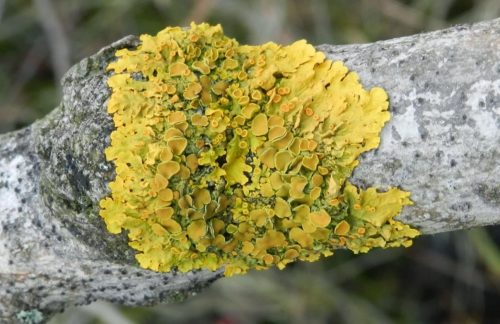
Lichens are a special group of organisms that result from the permanent coexistence between a fungus and an alga. The resulting vegetative body is completely different from a morphological, structural, and physiological point of view compared to the two partners that make the symbiosis.
The fungus cannot produce its food, so it is dependent on another life form. Green algae have a green pigment, chlorophyll, so they can do photosynthesis and produce nutrients. The alga surrounded by the mushroom provides it with the food it needs to exist. Thus, lichens produce the necessary food themselves and do not feed on the bark of the trees, using it only as a support.
Lichens and trees
Lichens are common on tree trunks and branches because their bark provides a suitable place to collect light, water, and airborne substances. We also find them on healthy trees, but in most cases, lichens are found on old trees, in decline or under stressful conditions. We find them more often on the trunks and branches of old trees because they have a partially defoliated crown, thus ensuring more light for the lichens. Also, the exfoliated, rough bark is better support for them.
Often, the presence of lichens is associated with the cause of tree diseases. Studies have shown that lichen is not harmful to the tree, but other fungi can penetrate the dead tissue and damage the wood. Thus, the dead tissue of the tree must be removed.
Even if they are not directly harmful, lichens are the host for pathogenic fungi and insects. The portions on which lichens grow can be cleaned through scraping, then treated with a cupric fungicide and coated with mastic.
Recommended products
-
You can find products on a different store
Change Store -
You can find products on a different store
Change Store -
You can find products on a different store
Change Store -
You can find products on a different store
Change Store -
You can find products on a different store
Change Store -
You can find products on a different store
Change Store -
You can find products on a different store
Change Store -
You can find products on a different store
Change Store -
You can find products on a different store
Change Store -
You can find products on a different store
Change Store -
You can find products on a different store
Change Store -
You can find products on a different store
Change Store -
You can find products on a different store
Change Store -
You can find products on a different store
Change Store -
You can find products on a different store
Change Store -
You can find products on a different store
Change Store -
You can find products on a different store
Change Store -
You can find products on a different store
Change Store -
You can find products on a different store
Change Store -
You can find products on a different store
Change Store -
You can find products on a different store
Change Store -
You can find products on a different store
Change Store -
You can find products on a different store
Change Store -
You can find products on a different store
Change Store
Recommended products
-
You can find products on a different store
Change Store -
You can find products on a different store
Change Store -
You can find products on a different store
Change Store -
You can find products on a different store
Change Store -
You can find products on a different store
Change Store -
You can find products on a different store
Change Store -
You can find products on a different store
Change Store -
You can find products on a different store
Change Store -
You can find products on a different store
Change Store -
You can find products on a different store
Change Store -
You can find products on a different store
Change Store -
You can find products on a different store
Change Store -
You can find products on a different store
Change Store -
You can find products on a different store
Change Store -
You can find products on a different store
Change Store -
You can find products on a different store
Change Store -
You can find products on a different store
Change Store -
You can find products on a different store
Change Store -
You can find products on a different store
Change Store -
You can find products on a different store
Change Store -
You can find products on a different store
Change Store -
You can find products on a different store
Change Store -
You can find products on a different store
Change Store -
You can find products on a different store
Change Store















































































































































































































































































































































































































































